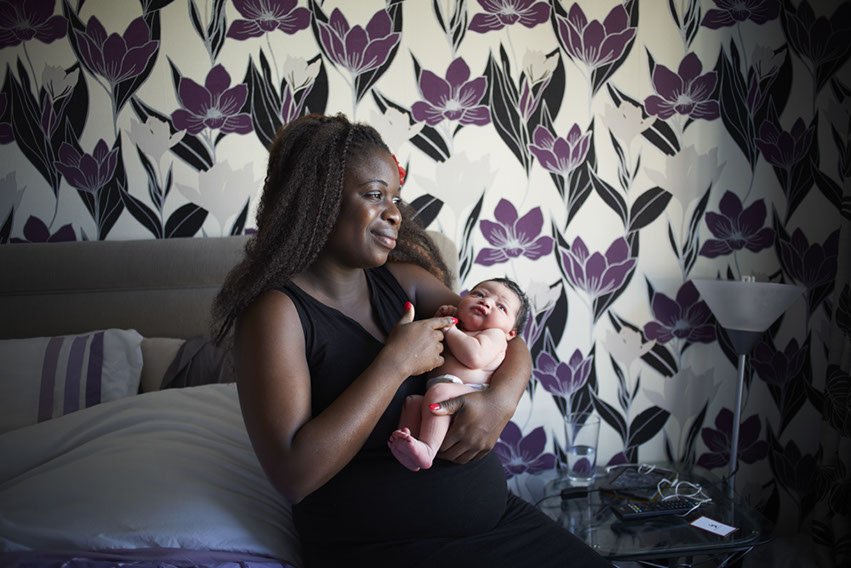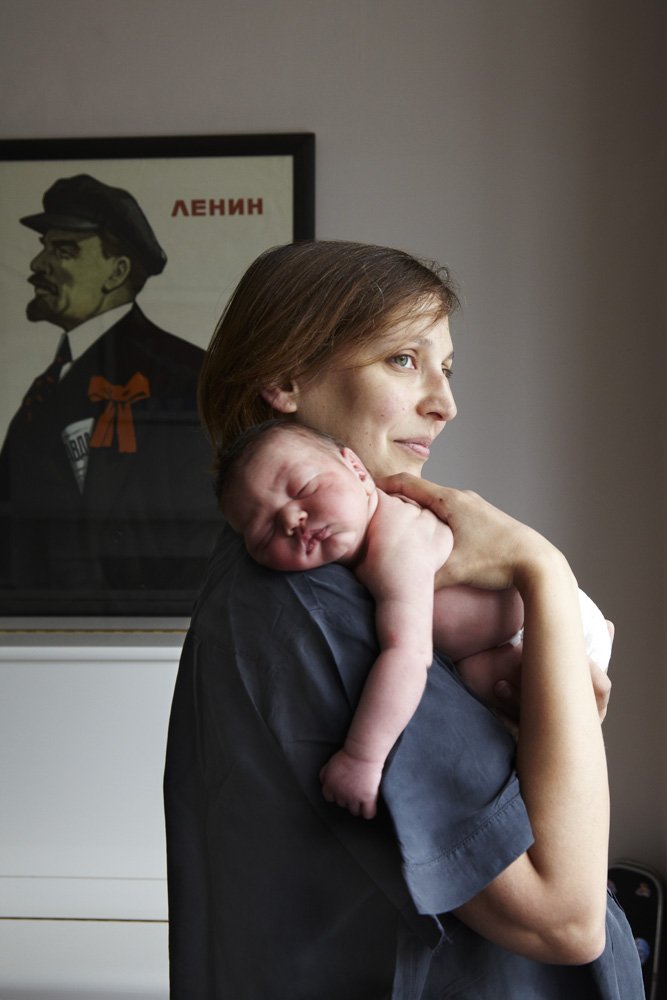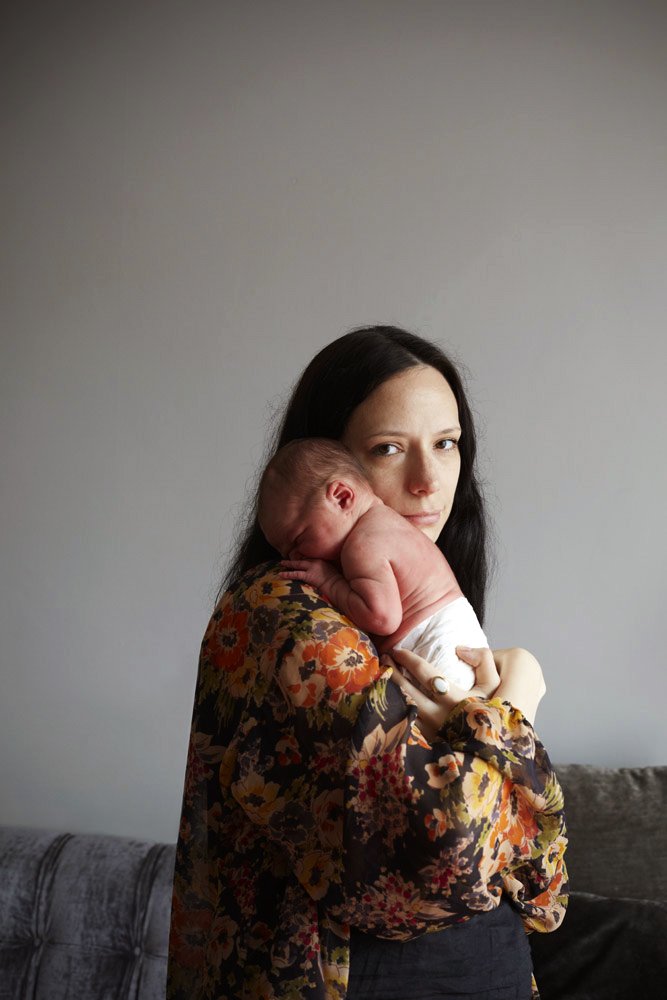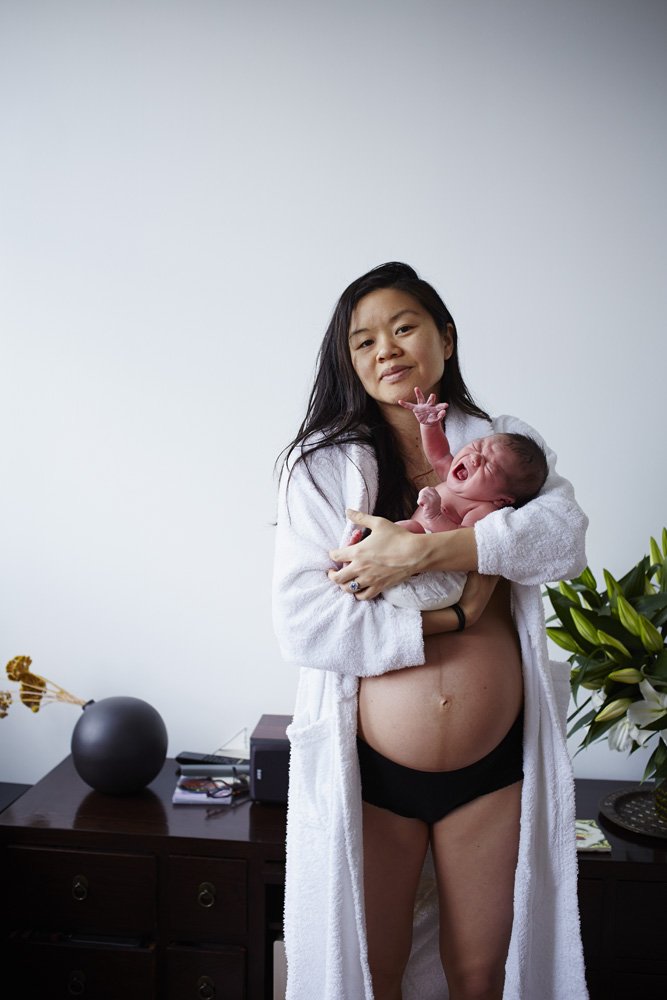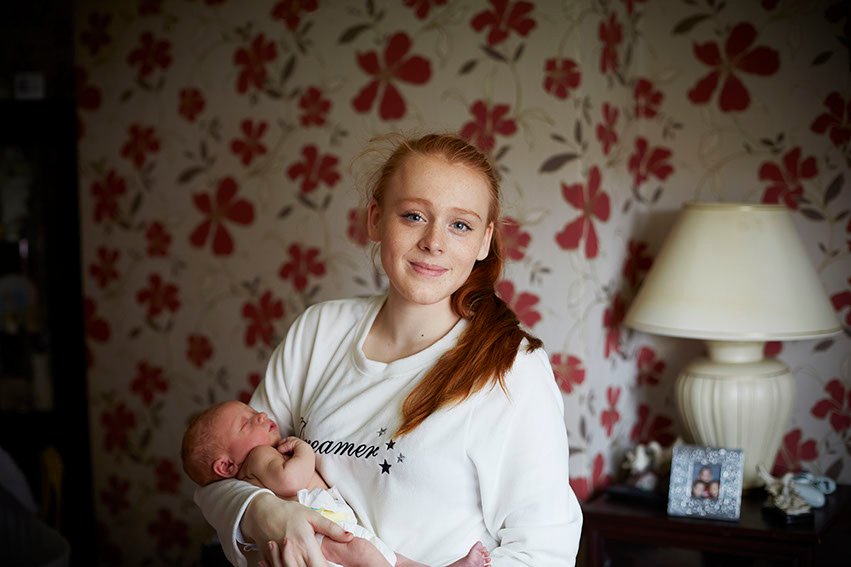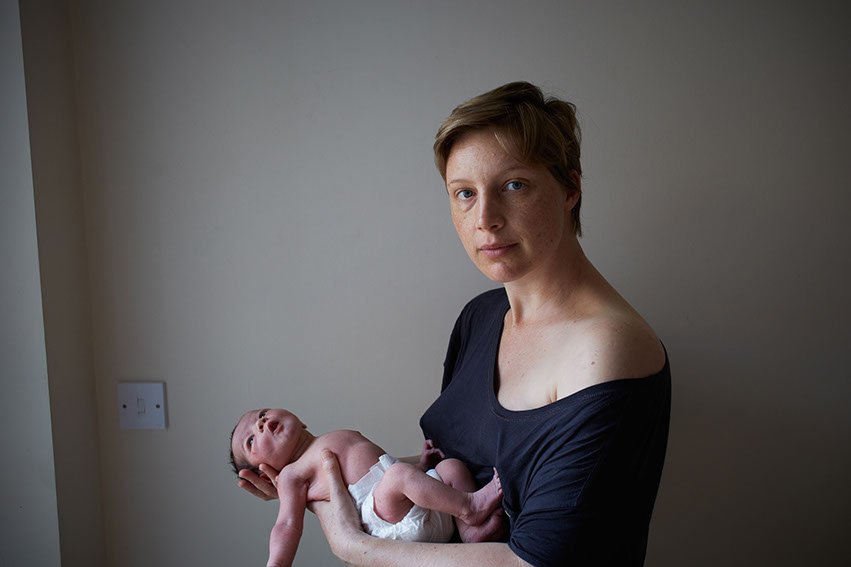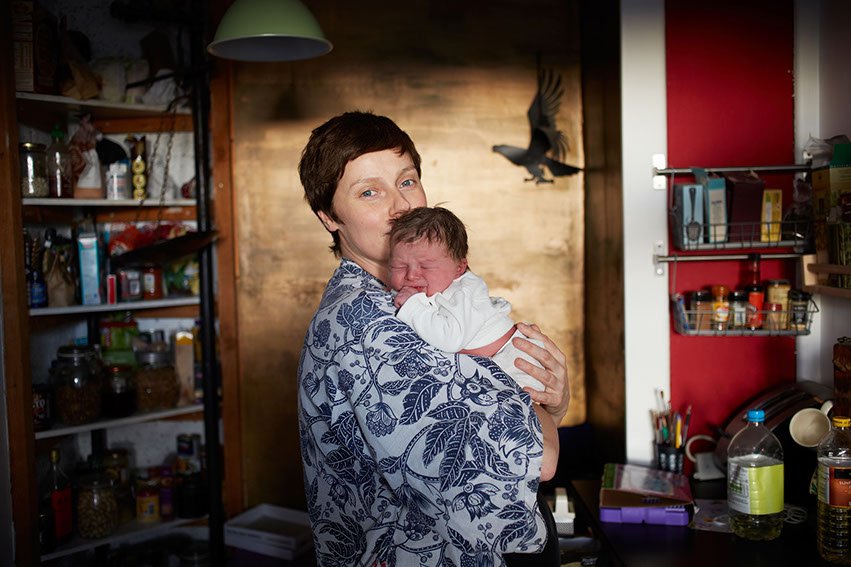With social media as its platform, family photography has found a new forum, a new way of showing the family, no longer hidden or medicalised in the private domain of the family album. I spoke with photographer Jenny Lewis about her beautiful series of portraits from One Day Young, Lewis’ portraits of women and their newborns are taken within 24 hours of birth, showcasing extreme intimacy and power with these new mothers, a true celebration of motherhood.
You don’t realise it till later, but I hadn’t thought about One Day Young, its been out for a year, I did loads of interviews and there has been a bit of a lull. Looking back on it with a bit of space I realised this whole thing, I photographed one hundred and fifty women and all I was doing was trying to find my own voice.
I became a mother and felt like I was disintegrating and invisible and didn’t have a voice anymore. By capturing all these other people and showing them as these warriors and strong women, I was just trying to say this is my tribe, I’m one of them, we are here. I didn’t think about that at all when I was photographing. In the introduction it isn’t about me trying to find that invisibility, I thought I was doing it for other reasons and you work through stuff.
I wonder if you look back at it ten years later, and you discover what was the motivation, it’s often something you couldn’t admit at the time, or didn’t even know. When I was giving talks about that project, I think people are almost surprised when they meet me that I’m not in a Laura Ashley frock and not a real girly person. Before I did it, I wouldn’t have dreamt of doing a project about motherhood, I was quite the tom-boy it would have made me be a bit like “oh that’s not me, I don’t want to be seen like this”, almost like men or male journalists would be, the people that are really criticised, it’s like fucking hell I was one of them.
Then I became a mother, I felt absolutely furious that it wasn’t a moment that was celebrated and that it was all just a bit “Hallmark cards” and soft. There is nothing soft about it they are warriors! So it was just out of pure anger and frustration this project evolved, then the project starts telling you stuff, and its not just about fight, fight, fight, its about love and joy and acceptance and being open with complete strangers, it’s not all of these little individuals doing their own battle, this is women on a level playing field.
You have mentioned alot about your own preconceptions on teenage mothers before starting this series?
Yeah! I mean, I was not going to put the book out unless I had a teenage mother. I didn’t want them to be invisible; I wanted to be there I wanted to celebrate them as much as everyone else. But when I went and saw Xanthe I realised I was shocked, that she was really calm, she was really mature and she was really happy, really confident. So something in my brain was expecting a little bit of vulnerability, “oh poor girl is she alright.” There is none of that there! Even though I didn’t feel that I was putting teenage mothers in a box, there was a part of my brain that was belittling and being a bit patronising, because I don’t know a teenage mother so what is my experience – everything that has been in the paper. There are a couple of mums at school but they are in their forties and they have twenty year old and a four year old, so I’ve met them when they have got through it, if you know what I mean.
It also made me realise something else. I think I photographed about 5 or 6 teenage mums and everyone was just brilliant. Until I met the girl in the children’s home and then you realise that’s what it is, you can be full of confidence but you do need some support, Xanthe was at home with her mum, another girl was at her mums house, someone was at her sisters house, someone else was is a hostel, so she was on her own but she had great support from nurses who I had met, she was still really bloody tough! I met her on that week after and she just looked absolutely amazing and I thought there was no way I looked like that at seventeen and I had so much pride for her and respect for her. That’s what I want people to see when they see those pictures, give these girls respect, don’t belittle them don’t patronise them.
When I met another girl, whose name I won’t mention, she was only 14. She had nothing, in the most depressing place and she didn’t want her face in the pictures. She was so confused about everything, there was a girl who was in the most vulnerable situation, but she had no support so of course she isn’t standing there beaming looking confident, her whole world is in chaos with no one to talk to, or to help her out.
That project is all about empowering women, but if you strip everything from them, their neighbours, friends, family, their home then no one can burst through that in the first week it’s just too much. But they are the people who really did slip through the net, the people who do need support more than anyone. It was so sad to see loopholes, government loopholes that they couldn’t give her a room in a hostel because she was fourteen and you have to be eighteen, so what she gets is a shit-hole, a horrible house in the middle of nowhere, no one was fighting her corner.
As a photographer, it must be hard to see. You put yourself in a situation like that, and you are, in a way giving back to these people through these images.
It’s a responsibility to her, she asked not to have her face in any of the images, In the end I wasn’t doing her for the project, it wasn’t one day old so couldn’t use her for the book, it was just a portrait for her to keep, there was no one else around her to take a picture of her and her baby, you got that feeling that she might lose the baby and it might be taken off her, she was put in the most desperate circumstances, so I just wanted to do a picture for her. She didn’t want her face in any of the pictures so I asked if she wanted just a picture of her with her baby, so that she has this really special time, I mean in the back of my head I was thinking fucking hell are they going to take the baby from her, I’m not saying that, but if things do work out and she gets into a better situation, I thought she doesn’t have a camera or a phone, I wanted to do it for her, not necessarily to post on Instagram, so for the Photographers Gallery take over I wasn’t going to post those pictures, because it isn’t part of the series, it was a week later and her face isn’t in it.
There are one-hundred thousand people (followers – Photographers Gallery Instagram) here listening, they are probably all in pretty comfortable situations and in need of a wake up call. Just because there are children’s home in England doesn’t mean they are any good, doesn’t mean that they give any support, so I wanted to give people a bit of a poke. Don’t be damming when you see a young girl struggling in the shop with a toddler screaming, she probably has allot of shit going on.
It’s difficult, it really is a mix of responsibility to that person in the picture, would they be happy with you sharing it, would they be happy with you sharing their story. I felt that as well, the girl in the hostel, I know she follows me on Facebook and Instagram, so I know she is going to be reading it. I’m fully aware of that, I’m not trying to sneak a story past her, but I want to get that pride and respect across for her but without her feeling uncomfortable that her moment and story is being shared with people, would she be cool with that?
Its just a balance all along, I suppose that everyone that did One Day Young – I leafleted the borough, I didn’t meet anyone before hand but we did email and communicate. Everyone that had their picture taken it is because they came to me, not me hunting people down. They knew what it was for and knew it was going to be used in a book or magazines, and they were happy to do it, if they weren’t, they weren’t going to contact me, so I have model releases and I know they are happy. Everyone got free pictures the day after I shot them.
I had one-hundred percent response from the women, they are so proud to be part of the project, to be spreading that message of empowerment to other women. Not only are they being celebrated they are supporting other people. I haven’t felt or heard that any one has felt used or they don’t want their picture sharing any more or stop talking about it.
The poor woman who went on the front! I said I’m sorry hazel I didn’t realise it was going to have quite so many articles, you know Fern Cotton taking a picture on her Instagram with like three hundred million followers, she was like “Jesus Christ I cant go to the corner shop – Celebrity in my own street!”
I look at your work as a photographer myself, or I would like to say I was anyway!
You never feel you are.
Really?
You never feel you are, I’ve been a photographer for – if you want to call it that, I don’t know what you call it – for twenty years, and freelance for twenty years as an editorial photographer, and you only feel like a photographer when you have a job booked in. I mean, I am a bit better now, but if you have a couple of weeks in between, as soon as you’re not getting booked for a job you just feel, well what am I, no one wants me. It’s really confusing. You’re only a photographer when you have the camera in your hand.
So how did you start off as a photographer?
I did a fine art degree and then I came down to London, slept on someone’s floor and worked in Metro Imaging as a black and white processor. Hundreds of rolls a day, war photography, fashion photography, editorial, so I did two years in a dark room and that gave me an amazing groundwork for the industry side of photography and how it works, you meet all the photographers. I didn’t even know there was a job “photographer’s assistant” but you meet all the photographers bringing film in and get invited to exhibitions etc. So that was an amazing start.
I then assisted for about four or five years, with fashion photographers like Liz Collins, Donald Christie, they are all quite big fashion photographers. Then I assisted a portrait photographer called Polly Borland, whose really funny and we really clicked, then I was like “Oh right!” this is what I need to be doing. It’s all about the meeting people, talking to them, not about the clothes not about selling something; it was the human interaction I love.
I love that as much as the picture. If you can make someone feel comfortable and relaxed, you can get a good picture, the chat is just as important as the what’s left, the picture is just what’s left after this interaction and if that’s gone well, then you will have a good picture. That’s when I realised that portrait photography just felt natural to me.
And that shows through your One Day Young project, they are such incredibly intimate portraits. As you have said yourself, the project has this strength and power through their pose. I read that you tend to shoot alone?
Absolutely. When I worked for years as an editorial photographer, I have assistants, hair and make-up, stylist, art directors, you have a whole team. Then it becomes my battle to make the person feel comfortable with this bloody unnatural audience.
Obviously I was working on my own project I didn’t have the money to pay for assistants or anything else, so I just did it on my own. I would cycle there with my camera, and that simplicity, I now put into my editorial work because I am increasingly finding it harder and harder to work with a team because you don’t have that magic one on one.
Also photographing someone when they are having their peak of endorphins, an hour, two hours or three hours after having a baby, you have a magic time, they are so confident and proud of themselves and they rightly should be. They don’t have that self-consciousness of “am I being a bit smug” or “am I showing off” they don’t give a fuck. You have them just being them and it’s so beautiful.
You really see it in the images
It’s amazing; maybe that’s why I did it for five years. You start absorbing that happy drug in the air.
You went to Malawi with the concept right?
Yeah, that happened after the book, and that was amazing, I did always want to travel with the project and just see what would that moment be like in other cultures, I had an idea that, that would be the look and the empowering body language would be the same with the women but just with a different background, but you never know. I was thinking about it and I thought, it’s kind of patronising, here is a white women going off to see what this moment is like in other cultures.
So I guess you wanted to stay away from that sociological sensationalism?
Well yes, I thought it isn’t a story for me to tell, that’s for someone else. I felt uncomfortable. I wanted to know what it would be like in Brazil, I mean Brazil has a ninety-nine percent caesarean rate, it’s a very different birth culture over there. There was a lot of stuff I wanted to investigate just through interviews I had with journalist in France and Brazil. I just didn’t get It, how to do it without being patronising, if you don’t feel it is authentic and a true voice, it’s going to be awkward.
When Water Aid asked me to go to Malawi I really wanted to do it and if this project in anyway could help highlight their campaign, I had to do it, but I was really nervous that I was the wrong photographer to do, it should be someone over there. I had this vision of privilege turning up in a Jeep with a translator!
But it was brilliant and worked really well. It took months to organise with so much red tape, and once it was sorted it was great. We worked in a health centre and took four hours a day to get there, it was in the middle of nowhere, no water so midwives couldn’t wash their hands, floors can’t be cleaned, not just talking about people being thirsty, which was again my naivety.
We shot exactly the same; talking to women if they wanted to do it we would take them home and do a portrait of them in their own space and their own identity and surroundings.
Is that how you kept the intimacy with language barriers and culture differences?
I think it’s that whole of thing being in that institution, although it was just sort of a shed. You haven’t got your identity around you, these women didn’t really have allot, so it is not all their possessions but you feel that you’re the mum and you are back home and this is your role, these are your children around you, that’s your husband and this is your house and this is you.
Where as in the institution you have hundreds of women waiting, they’re going to be self-conscious because everyone can see them getting their picture taken, they’re not relaxed, maybe they just want to get home. I didn’t want to have the background of the hospital, just like in England with the green curtains what does that say about anyone, and in Malawi I didn’t want the decrepit broken hospital beds, that’s a different story, that’s an aid workers story. It was about the women for me, it was about their body language, their eye contact. That confrontational gaze, isn’t brilliant, they are such strong women.
Your work is inspiration to many photographers, what is the best advice that you could give to graduates and new photographers, what is it that you have learnt?
Find your voice. Doing my own projects and finding my voice has given me so much confidence. I have got something to say that people might want to listen to and that is relevant. I learnt that whilst doing the project, social media has helped with confidence and that wasn’t around when I started out. Be aware of social media and the power it has.
Make sure you find the blogs that will get to the right people, getting this sort of material will be hard to get into a gallery, getting it on blogs will get to more people so don’t dismiss that as it’s not in the Sunday Times spectrum, which it did get into eventually but that was my sort of epitome of an eight page glossy photo story, I’ve made it! But actually it got more people looking at it through some of the blogs it was featured on.
I think that you guys are in a really good position you understand the power and how social media works, it’s a great tool.
